Live
- They always want me to win, and now I feel lucky to have been offered a story like ‘Zebra’: Satyadev Kancharana
- ‘Democracy first, humanity first’: PM Modi in Guyana's parliament on two countries' similarities
- PKL Season 11: Telugu Titans register third straight win to top standings
- Is Pollution Contributing to Your COPD?
- NASA Unveils Underwater Robots for Exploring Jupiter's Moons
- Additional Central forces arrive in violence-hit Manipur
- AR Rahman and Saira Banu’s Divorce: Legal Insights into Common Issues in Bollywood Marriages
- 82.7 pc work completed in HPCL Rajasthan Refinery area: official
- Curfew relaxation extended in 5 Manipur districts on Friday
- Tab scam prompts Bengal govt to adopt caution over fund disbursement
Just In
Green hydrogen: Costs & safety critical


Green hydrogen: Costs & safety critical
Hydrogen is used mainly to make chemicals such as fertilisers, and in oil refineries
Hydrogen is used mainly to make chemicals such as fertilisers, and in oil refineries. Most hydrogen in the world today is made from natural gas or coal – methods associated with large carbon dioxide emissions. Developed countries are therefore looking to "green hydrogen" instead – produced using renewable electricity such as solar and wind power.
Global hydrogen demand reached 94 million tonnes in 2021, and contained energy equal to about 2.5 per cent of global final energy consumption. Only about 0.1 per cent of current global hydrogen production is green, but big expansions are planned. New applications for green hydrogen are also envisaged. Green hydrogen currently costs much more to make than less clean types of hydrogen. Using it to produce the 180 million tonnes per annum of ammonia required globally for fertiliser production would have a severe knock-on effect on food prices. So it is difficult to see how this transition is going to occur.
Green hydrogen is made from water. Using renewable ("green") electricity, equipment called electrolysers separates the hydrogen from oxygen in water (H2O). The process is called electrolysis. Green hydrogen production emits no carbon dioxide, but the construction of renewable electricity infrastructure currently uses fossil fuels, which do emit carbon dioxide. Hydrogen has traditionally been made from non-renewable energy sources like coal ("black hydrogen") and natural gas ("grey hydrogen"). When these methods are combined with carbon capture and storage, the hydrogen produced is known as "blue hydrogen."
Although the costs of renewable power generation have been coming down, the cost of electrolysis is still not commercially competitive. Today, green hydrogen has an estimated energy equivalent cost of between $250 and $400 per barrel of oil at the factory gate, according to the International Renewable Energy Agency. Future cost reductions are forecast but these are uncertain. Current oil prices are around $100 a barrel – much less than it would cost to use green hydrogen instead of conventional petroleum products. The costs of transporting hydrogen must be taken into account too. Unfortunately, the physics of hydrogen is against low-cost hydrogen transport. It is much more challenging than oil-based liquid fuels, liquefied petroleum gas or liquefied natural gas. Ocean transport of hydrogen has to be at very low temperatures (-253 C).
Because ammonia (NH3) is much easier and cheaper to transport than hydrogen, the International Renewable Energy Agency has recommended "storing" hydrogen in ammonia for shipping. But that requires additional equipment to put the hydrogen into ammonia and strip it out at its destination. These processes add costs of about $2.50-$4.20/kg (equivalent to $123-$207 per barrel of oil) according to the agency. Hydrogen is more difficult to handle than conventional fossil fuels. It is a colourless, odourless and tasteless gas, unlike conventional hydrocarbons. This makes leak detection more difficult and increases the risk of fire or explosion. Hydrogen fires are invisible to the human eye.
Historically, hydrogen has been controlled within factory perimeters and managed by trained people. The widespread introduction of hydrogen into society will require new measures and skills, including insurance, materials handling, firefighting and disaster management.
Construction of the first gigawatt scale green hydrogen project in Saudi Arabia has already started. Many of the pioneering projects will be built in the southern hemisphere, mostly in developing countries. This is because they are less densely populated and have better renewable energy resources (solar and wind) for generating the necessary electricity. Although this may sound positive for developing countries, there are big risks in developing hydrogen mega projects. They will have to balance these risks against the temptations of improved investment, employment and balance of payments. They would be wise to extract guarantees from their customer countries so as to avoid the injustice of the global south subsidising the global north as it transitions to cleaner energy.
(Crompton is Visiting Adjunct Professor, African Energy Leadership Centre, Wits Business School, University of the Witwatersr, Johannesburg; and Douglas is Senior Lecturer, Africa Energy Leadership Centre, Johannesburg; The Conversation)

© 2024 Hyderabad Media House Limited/The Hans India. All rights reserved. Powered by hocalwire.com






